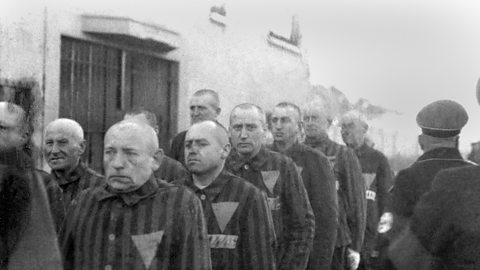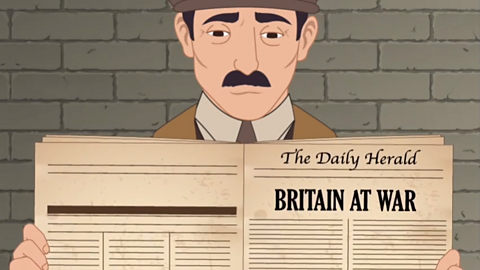Key points
Many groups of people were persecuted in different ways and for different reasons by the Nazis.
The Nazis wanted to create a so-called 'Aryan race'An idea developed in the 1800s, believed by Hitler and the Nazis, that people from northern and western Europe were racially 'superior' to other groups. There is no scientific basis for this idea.. They persecuted and murdered people that they believed did not fit in with this.
Different ethnic groups, political opponents, gay men and people with disabilities were all persecuted by the Nazis.
Introduction
Jewish people were the single biggest group who were persecutionTreating people poorly based on their political beliefs, race, religion or sexuality. by the NaziAn abbreviation for the National Socialist German WorkersÔÇÖ Party (NSDAP) and its members. The term was originally thought up by political opponents of the party. The Nazi Party's main ideas were based on racism, including antisemitism, and hostility towards democracy and other political systems, such as communism and socialism.. Other groups of people were targeted for different reasons:
Non-Jewish Slavic peoplesAn ethnic group living in Poland, the Soviet Union, Ukraine, Yugoslavia, Czechoslovakia and Bulgaria., RomaAn ethnic group originating in South Asia who migrated to Europe from the Middle Ages onwards. and SintiThe group of Roma people who lived in central and eastern Europe., Black people and mixed race people were targeted because they did not fit within the NazisÔÇÖ racist idea of a master 'Aryan race'An idea developed in the 1800s, believed by Hitler and the Nazis, that people from northern and western Europe were racially 'superior' to other groups. There is no scientific basis for this idea., and were seen as so-called ÔÇÿracial enemiesÔÇÖ.
communistSomeone who believes in the political ideology of communism, a system of running a country in which all means of production such as tools, factories and raw materials, are owned by the community as a whole. Private property does not exist and each individual contributes according to their ability and receives according to their needs. This means there is no hierarchy of social class., trade unionistA member of a trade union, which is an organisation of workers formed to protect the rights of its members. A trade union might argue for better wages or working conditions., Soviet prisoner of warA person who is captured and held by the forces of the opposing side during a war. and Jehovah's WitnessesA Christian group founded in the 1800s who disagree with many traditional Christian teachings and beliefs. suffered persecution because they were political opponents of the Nazi regime.
People with disabilities were persecuted because the Nazis believed that they were genetically ÔÇÿinferiorÔÇÖ, and posed a threat to GermanyÔÇÖs ÔÇÿracial healthÔÇÖThe Nazi idea of securing the ÔÇÿpurityÔÇÖ of the ÔÇÿAryan raceÔÇÖ. Germans were taught to choose their partners for marriage carefully to avoid mixing their ÔÇÿbloodlineÔÇÖ with people with disabilities or people of different races, particularly Jews and Roma and Sinti..
Gay men were targeted for persecution because the Nazis believed that they were ÔÇÿfailing to contributeÔÇÖ to the creation of a so-called ÔÇÿAryan raceÔÇÖ by supposedly not having children.
While these groups were all targeted for different reasons, their persecution was rooted in the NazisÔÇÖ racist, unscientific and prejudiced beliefs.

Polish people and other eastern European civilians
The NazisÔÇÖ racist ideas meant that they saw the Slavic peoples who lived in eastern Europe, including Polish people, Russians and Czech people, as ÔÇÿinferiorÔÇÖ to Germans. Hitler wanted to follow a policy of ÔÇÿLebensraumÔÇÖ, which meant taking over land in eastern Europe as ÔÇÿliving spaceÔÇÖ for the German people.
When Germany invaded and occupied Poland in September 1939, Polish soldiers and civilianA person who is not a member of the armed forces, police or actively involved in fighting in a conflict. suffered terrible violence at the hands of the Nazis. When Auschwitz concentration campA place where large numbers of Jewish people, and members of other minority groups persecuted by the Nazis, were held captive during World War Two. was set up in 1940, it was intended to hold Polish prisoners who opposed Nazi occupation. 70,000 non-Jewish Polish people eventually died at Auschwitz.
The Nazis particularly targeted the intelligentsiaA group of highly educated people who are involved in shaping the culture, art or politics of their society. In Poland, members of the intelligentsia were university professors, journalists and writers, among lots of other jobs. and education in Poland. In October 1939, 183 professors who were working at universities in Krak├│w were arrested and sent to concentration camps in Germany. The Nazis closed all of the universities and secondary schools in Poland, so that people couldnÔÇÖt be educated to become leaders.
In an attempt to achieve the ÔÇÿLebensraumÔÇÖ policy aim, around 400,000 Polish people were expelTo force a person or group of people to leave a country or organisation. from the west of Poland between 1939 and 1941. After the invasion of the Soviet Union in 1941, the Nazis planned to expel even more people from their homes in eastern Europe. These plans were not carried out in full because of military setbacks during the war. However, the Nazis expelled 110,000 people from 287 villages in the Zamo┼ø─ç region of Poland. Adults and older children were sent to work as forced labourers in Germany, or to the Auschwitz and Majdanek concentration camps. The majority of younger children, elderly people and those who were ill or disabled were expelled and left to starve.
More than 2 million Polish people were sent to Germany as forced labourers, where they had to work for very low wages and were made to follow discriminationTreating people differently on the basis of a particular characteristic, such as race, religion or sex. laws, such as not being allowed to eat in restaurants.
The NazisÔÇÖ response to anyone who resisted their policies in Poland was to use extreme violence. Huge numbers of civilians were executed, and many villages were destroyed.
Historians estimate that between 1.5 and 1.8 million non-Jewish Polish people died during Nazi occupation. In the Soviet Union, millions of Soviet civilians died as a result of the NazisÔÇÖ policies.
Soviet prisoners of war
When the Nazis invaded the Soviet Union in 1941, they treated captured Soviet troops terribly. The Nazis saw Soviet prisoners of war as their enemies for political reasons, and also because they wrongly believed that they were racially ÔÇÿinferiorÔÇÖ.
Conditions in prisoner of war campPlaces where captured enemy troops were held. International rules set out conditions and expectations about how prisoners should be treated. However, some countries, including Nazi Germany, did not stick to these rules, and treated prisoners of war very badly. for Soviet prisoners were horrendous. There was a deliberate policy of starvation and inmates were forced to do hard labour.
Of the 5.7 million Soviet prisoners of war who were captured during the invasion of the Soviet Union, 3.3 million were killed.
Roma and Sinti
The Roma and Sinti had migrated from Asia to countries across Europe since the Middle Ages. When the Nazis came to power in 1933, there were approximately 30,000 Roma and Sinti in Germany. They were wrongly considered to be racially ÔÇÿinferiorÔÇÖ by the Nazis.
From 1933, laws were introduced to persecute Roma and Sinti. They were sterilisationA medical procedure that prevents someone from being able to have children. and had their civil rights taken away following the 1935 Nuremberg Laws. This meant they lost their right to be German citizens and marriages between Roma and non-Roma people was banned. In the summer of 1936, before the Berlin Olympics took place, around 800 Roma were arrested and imprisoned in a concentration camp just outside Berlin. Like Jewish children, Roma children were barred from going to school in 1941.
Following the invasion of the Soviet Union, the EinsatzgruppenMobile units of the Nazi security forces (the SS) who were responsible for mass killings, usually by shooting, across Nazi-occupied Europe. moved into occupied land taken by the German army. They rounded up Roma and Sinti and shot them dead. 23,000 Roma and Sinti were sent to Auschwitz-Birkenau, where many died due to the terrible conditions, with others sent to the gas chambers when they became too ill or weak to work. Historians estimate that around 21,000 of the 23,000 Roma and Sinti who were sent to Auschwitz were murdered there.
The NazisÔÇÖ collaboratorA person, organisation or country who worked with the Nazis to persecute and murder Jewish people, and other targets of Nazi persecution, during World War Two. also enabled the persecution of Roma and Sinti. For example, in France, the Vichy governmentThe government of France from July 1940 to August 1944, led by Marshal Philippe P├®tain. Though France had begun the war on the opposite side to Nazi Germany, the Vichy government collaborated with the Nazis, and introduced antisemitic laws. rounded up 30,000 Roma and Sinti and imprisoned them. The majority were then sent to concentration camps. In Croatia, which was an ally of Nazi Germany, FascismA type of far-right government that first appeared in Europe in the early 1900s. Fascist countries are usually ruled by one party, which are led by a dictator who has all of the power. Other features of a fascism include the use of violence against political opponents, the government keeping tight control of different aspects of everyday life, racist beliefs and discrimination against minority groups. killed thousands of Roma and Sinti, as well as Jews and SerbsAn ethnic group living in the Balkans, in the south-east of Europe. .
Historians estimate that around 220,000 Roma and Sinti were murdered by the Nazis.
Black people
By 1933, the Black community in Germany numbered around 25,000 people. Before Hitler came to power, there was already racism against Black and mixed race citizens.
Mixed race children were sterilised and some Black German citizens were sent to camps to carry out hard labour. The Nazis saw mixed race children as a threat to the purity of the unscientific ÔÇÿAryan raceÔÇÖ that they wanted to create.
There is evidence to suggest that Black prisoners of war from the USA, France and Britain were treated worse than their white peers. Some Black prisoners of war were singled out by the guards at the camps and mistreated, or even murdered.
Who was Theodor Wonja Michael?
Theodor Wonja Michael was born into a mixed race family in Berlin in 1925. His father was from Cameroon, and his mother was from Germany.
After leaving school in 1939, Theodor worked as a porter in a Berlin hotel but was sacked after a guest complained about being served by a person of colour.
He struggled to get other jobs because he was not allowed to join the Nazi workersÔÇÖ organisation, the German Labour Front. However, he unexpectedly found work during the war as an extra in propaganda movies, which glorified German colonialism.
Theodor was conscripted for the German army, but later rejected because he was Black. Instead, in early 1943, he was sent with other Black Germans to a labour camp. They were forced to work in a weaponsÔÇÖ factory until the end of the war.
Theodor later said that his greatest fear in the camp was falling ill. He feared that he might be sterilised in hospital, as mixed race children from the Rhineland region had been.
After the war, Theodor worked as an actor, appearing in plays at the theatre and in TV programmes.
People with disabilities
To try and accelerate the creation of the so-called ÔÇÿAryan raceÔÇÖ, the Nazis persecuted people with disabilities in Germany.
Some scientists believed in eugenics. This was an incorrect idea that, through selective reproduction, they could create their ÔÇÿmaster raceÔÇÖ.
The Nazis had already started teaching children in schools about the cost of looking after people with physical and mental disabilities. This was part of a propagandaPutting forward biased information to persuade people to believe a particular point of view. campaign to persuade people that the persecution of people with disabilities was justified.
In July 1933, the Nazis introduced a law that allowed the sterilisation of people with disabilities. It is estimated that approximately 300,000 people had been sterilised by the end of World War Two.
In October 1939, Karl Brandt, who was HitlerÔÇÖs personal doctor, was put in charge of a new programme. It was designed to murder children who had severe disabilities. It is estimated that up to 5,000 children were murdered between 1939 and 1941.

Following the invasion of Poland in September 1939, a similar policy was introduced for adults with disabilities. It was known as the T4 programmeThe code name of the programme in which 70,000 adults with disabilities were systematically murdered in gas chambers between 1939 and 1941. It was named after Tiergartenstrasse 4, the address in Berlin where the policy was developed., named after its headquarters in Berlin. A panel of doctors decided which patients should be killed, and the victims were murdered in gas chambers at killing centresThe six sites in Germany that were converted into places where people with disabilities were murdered in gas chambers. The sites that were converted were mainly hospitals, and also included a former prison., hospitals or care homes. Families of victims were sent a letter telling them that their relative had died of natural causes.
The T4 programme officially ended in 1941, after criticism from the Church in Germany and questions from victimsÔÇÖ relatives. By the time the programme ended, 70,000 people had been murdered. The murder of people with disabilities was carried out by other means, including deliberate policies of starvation, until the very end of the war. It is estimated that around 200,000 people with disabilities were murdered during the Nazi regime.
Political opponents
Hitler had been appointed Chancellor of Germany in 1933.
Following the Reichstag fire in February 1933, an Emergency Decree was passed. This gave Hitler the power to arrest political opponents. Communist Party members were sent to concentration camps. Nazis hated communists. They also made links between communists and Jews, claiming that they were conspiring against Germany, which was completely untrue. The Communist Party had picked up a lot of support following the Great DepressionA global economic crisis that started in 1929 in the USA. It led to mass unemployment and hardship throughout the 1930s., as had the Nazi Party. This meant that the Nazis saw them as a threat to their power.
By the end of 1933, there were around 100,000 people imprisoned in concentration camps. Around three quarters of these people were Communist Party members.
Gay men and lesbians
Sexual relationships between men were already outlawed in Germany before the Nazis took power, under a law known as ÔÇÿParagraph 175ÔÇÖ. However, a more liberal attitude towards gay relationships had been developing in the 1920s. This changed under Nazi rule. The Nazis closed gay bars, nightclubs and newspapers. They wrongly believed that gay people were not making a ÔÇÿpositive contributionÔÇÖ to society as they were supposedly unlikely to have children.
From June 1935, Paragraph 175 was amended to increase punishments for homosexual relationships. This change led to an increase in men arrested for being gay, from 4,000 in 1933 - 34 to 22,000 in 1936 - 38. Fearing persecution, many gay men fled Germany when the Nazis took power in 1933.
The Paragraph 175 law applied only to gay men, so lesbians were not specifically targeted by the Nazis, but a small number were arrested. However, many lesbians lived in fear as there was societal pressure to ÔÇÿconformÔÇÖ to the NazisÔÇÖ ideas.
50,000 men were arrested for being gay. Many of the men who were arrested were given prison sentences, but from 1937 onwards, gay men were sent to concentration camps. Up to 15,000 were sent to the camps, where they were forced to wear badges in the shape of a pink triangle. The majority, though not all, of those who were forced to wear this badge identified as gay.
Many of those imprisoned died from exhaustion. Gay men were also subjected to cruel medical experiments.
Even after the war, Paragraph 175 remained in place in German law, despite the occupation of Germany by Allied forces.
Test your knowledge and inference skills
Question 1
Jewish people were the biggest single group to be persecuted and murdered by the Nazis.
- Which other groups of people suffered Nazi persecution?
- What reasons did the Nazis give for targeting these groups of people?
Non-Jewish Slavic peoples, Roma and Sinti, Black people and mixed race people were targeted as the Nazis wrongly believed that were they were ÔÇÿracially inferiorÔÇÖ.
Gay men were targeted as the Nazis wrongly believed that they were not contributing to society by supposedly not having children.
Political opponents such as communists, trade unionists, Soviet prisoners of war and JehovahÔÇÖs Witnesses were targeted because the Nazis believed that they were a threat to their power. They were also seen as potential opponents of the changes that the Nazis wanted to make in Germany.
People with disabilities were targeted because the Nazis believed that they were genetically ÔÇÿinferiorÔÇÖ.
Though all of these groups of people were targeted for different reasons, their persecution was rooted in the NazisÔÇÖ racist, unscientific and prejudiced beliefs.
Question 2
What was the T4 programme?
The Nazis developed the T4 programme to murder adults with disabilities. Hitler wrongly believed that people with disabilities were genetically ÔÇÿinferiorÔÇÖ, and that they would prevent the Nazis from creating a so-called ÔÇÿAryan raceÔÇÖ.
The programme was overseen by HitlerÔÇÖs personal doctor, Karl Brandt.
The programme officially ended in 1941. By this point, 70,000 people had been murdered under the T4 programme.
The gave advice and guidance during the production of this guide.
Play the History Detectives game! gamePlay the History Detectives game!
Analyse and evaluate evidence to uncover some of historyÔÇÖs burning questions in this game.

More on World War Two and the Holocaust
Find out more by working through a topic
- count1 of 10

- count2 of 10

- count3 of 10

- count4 of 10
